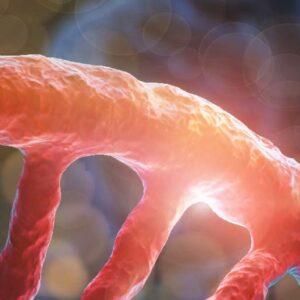Autosomal dominant polycystic kidney disease (ADPKD) is the most common form of polycystic kidney diseases. In Europe, it is considered a rare disease with a prevalence of approximately 1:2,000-2,500. ADPKD is characterized by a progressive development of fluid-filled cysts in all areas of the nephrons and collecting tubules and by a bilateral formation of enlarged, polycystic kidneys. Renal failure usually occurs between the ages of 30 and 70 years, leading to terminal renal failure in half of ADPKD patients by the 6th decade of life. However, a wide variability in clinical course from neonatal onset to healthy renal function in old age has been observed. ADPKD patients may have additional non-renal manifestations. Liver cysts are present in more than 90% of patients with ADPKD who are older than 35 years. Risk factors for more severe polycystic liver disease include female gender, exogenous estrogen exposure, and multiple pregnancies. Symptomatic polycystic liver disease affects approximately 20% of ADPKD patients, who present with complications related to the burden of increased liver cysts, such as pain, early satiety, gastroesophageal reflux, and in rare, most severe cases, portal hypertension with ascites and pleural effusion. The prevalence of intracranial aneurysms is four times higher in patients with ADPKD than in the general population, ranging from an estimated 9% to 12%. In patients with a positive family history of intracranial aneurysms, the prevalence is higher (approximately 22%) than in those without a positive family history (6%). Screening for intracranial aneurysms by magnetic resonance angiography is recommended for patients with a conspicuous family history of intracranial aneurysms or ruptured aneurysms and in patients with high-risk occupations. Other non-renal manifestations of ADPKD may include pancreatic cysts (8% of cases), hernias, and valvular heart disease.
Molecular genetic causes of ADPKD are primarily pathogenic variants in the PKD1 (78% of cases) and PKD2 (15% of cases) genes. The PKD1 gene comprises 46 exons, with exon 1-32 occurring further proximally on chromosome 16 in six duplicated copies as a pseudogene. The PKD2 gene comprises 15 exons. To date, the causative variants identified in both genes include all types of variants and are distributed across all exons. Genomic deletions are relatively rare in ADPKD, with 4% in PKD1 and less than 1% in PKD2. An exception is the TSC2/PKD1 contiguous gene syndrome, which includes large genomic deletions involving the PKD1 gene as well as the TSC2 gene adjacent to it. However, these patients show clinical symptoms of tuberous sclerosis with early manifestation of renal cysts. In addition, variants in the GANAB (approximately 0.3%) and DNAJB11 (approximately 1.2%) genes have recently been identified as a rare cause of a mild form of ADPKD. Pathogenic variants in the HNF1B gene may also cause an ADPKD-like phenotype. Currently, 7% to 10% of families affected by ADPKD remain genetically unexplained. Up to 25% of patients have no positive family history, and approximately 15-20% are explained by de novo variants.
In carriers with pathogenic variants in the PKD1 gene, ADPKD manifests earlier, and renal failure also occurs on average 20 years earlier compared to carriers with pathogenic variants in the PKD2 gene (58 vs. 79 years). Variants in the PKD1 gene that do not lead to a truncated protein show a much milder clinical course than protein-truncating PKD1 variants. In some cases with very early disease onset (less than 1% of affected families), biallelic inheritance has been reported, e.g., inheritance of a familial PKD1 variant in trans with a second PKD1 variant with significantly reduced penetrance. Patients who only carry the allele with reduced penetrance are unlikely to develop renal failure, but may show a small number of cysts in adulthood. Rarely, digenic inheritance with PKD1 and PKD2 or PKD1 and HNF1B has been described, also leading to more severe disease.
The gene products (polycystin-1 and -2) are transmembrane glycoproteins of the primary cilia of renal epithelial cells that interact with each other via their cytoplasmic C termini.
The polycystin1/polycystin-2 complex is involved in proliferation, apoptosis, differentiation, and the regulation of cell shape and diameter of renal tubules via various signal transduction cascades. Cyst development follows the 2-hit model, according to which, in addition to the germline mutation in one of the two genes, a second somatic mutation event in the same or the other PKD gene (transheterozygosity) inactivates the tumor suppressor function of both proteins (loss of heterozygosity, LOH). GANAB encodes the alpha subunit of glucosidase II, an endoplasmic reticulum (ER) enzyme involved in N-linked glycosylation. The ß-subunit of this enzyme is encoded by PRKCSH, one of the major genes involved in autosomal dominant polycystic liver disease. The product of the DNAJB11 gene is one of the most common co-factors of BiP (also known as HSPA5 and GRP78), a heat shock protein chaperone. The commonality between these genes is that they are thought to lead to impaired folding, maturation, and defective transport of membrane or secretory proteins in the endoplasmic reticulum with a particular dose sensitivity to PC1, resulting in renal or hepatic cyst formation.
References
Cornec-Le Gall et al. 2019, Lancet 393:919 / Gimpel et al. 2019, Nat Rev Nephrol doi:10.1038/s41581-019-0155-2 / Douguet et al. 2019, Nat Rev Nephrol 15:412 / Cornec-Le Gall et al. 2018, J Am Soc Nephrol 29:13 / Haumann et al. 2018, medgen 30:4225 / Cornec-Le Gall et al. 2018, Am J Hum Genet 102:832 / Willey et al. 2016, Nephrol Dial Transplant 0:1 / Kühn et al. 2015, Dtsch Arztebl Int 112:884 / Consugar et al. 2008, Kidney Int 74:1468 / Phakdeekitcharoen et al. 2001, J Am Soc Nephrol 12: 955





















